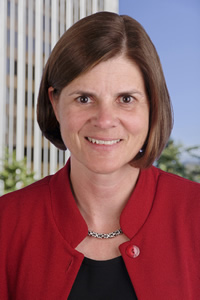Being very involved in getting environmental permits to build renewable energy facilities, I am very interested in the question of how the industry is going to solve the grid integration issue. Since renewable energy is generated during daylight hours and the highest period of demand is in the evening, there is a mismatch.
Energy in California Conference 2014
Annie Mudge | Cox, Castle & Nicholson
Your Energy in California programming lists energy storage and integrating renewable resources through capacity markets as key examples of cutting-edge areas in the field. Can you expand on these examples and share other hot topics that received attention at the conference?
 A major topic of discussion for the renewable energy industry continues to be: how to integrate renewable energy onto the grid. Being very involved in getting environmental permits to build renewable energy facilities, I am very interested in the question of how the industry is going to solve the grid integration issue. Since renewable energy is generated during daylight hours and the highest period of demand is in the evening, there is a mismatch. This creates a very quick ramp up of demand in the late afternoon to early evening, and the renewable energy industry is working to address this mismatch. It is not clear yet whether storage or pricing strategies will be an answer to addressing the issue, or something else entirely.
A major topic of discussion for the renewable energy industry continues to be: how to integrate renewable energy onto the grid. Being very involved in getting environmental permits to build renewable energy facilities, I am very interested in the question of how the industry is going to solve the grid integration issue. Since renewable energy is generated during daylight hours and the highest period of demand is in the evening, there is a mismatch. This creates a very quick ramp up of demand in the late afternoon to early evening, and the renewable energy industry is working to address this mismatch. It is not clear yet whether storage or pricing strategies will be an answer to addressing the issue, or something else entirely.
There are ongoing industry discussions about trying to get base load sources such as fossil fuel and natural gas to ramp up even more quickly. There is also a lot of talk around demand-response strategies to encourage people to access energy at different times of day.
There is a whole suite of ideas, but is there one silver bullet? Not yet. Over the course of the two-day conference, there wasn’t one ah-ha moment where everybody said, “This is going to be the answer.” There are a number of solutions that are being considered, and I think that storage is one of the top solutions.
Your programming for your “Environmental Impact Review Processes for Energy Projects” panel at Energy in California mentions “recent CEQA case law developments of particular importance to energy projects.” What are these developments and how will they impact energy projects in California?
One of the main drivers for the renewable energy market in California has been the Renewable Portfolio Standard (RPS), which is currently at 33 percent. At the beginning of 2014, the California Legislature said, “We are going to allow the California Public Utilities Commission (CPUC) to lift that 33 percent to something higher, like 40 or 50 percent.”
However, because of the integration problem, there is reluctance towards requiring the utilities to purchase more than 33 percent renewable energy. People are concerned that this would simply lead to projects being put online, only to be curtailed during times of high generation and lower demand. This concern is putting a damper on the enthusiasm of the government to increase the RPS above 33 percent. Balanced against that dynamic is the desire to reduce greenhouse gases through AB32. We have a tension between AB32 driving the RPS standards to 33 or more percent, and the inability to integrate renewables onto the grid, thereby placing a downward pressure against making this change.
What did you learn from your time at the conference? How would you describe the most provocative information that you took away from the conference, personally?
There are technical issues that must be resolved to integrate renewables on the grid. There is a political will to increase renewable energy in California, but this obstacle must be overcome before the legislation will increase the RPS and impose a new requirement on the utilities. Developers are not going to build new renewable energy projects if they cannot be guaranteed that they are going to get paid for energy generated. If they have to sit and let their equipment be idol, and not get paid, they are not going to build.
Prior to the conference, I was not as aware of the magnitude of the integration problem and the arresting impact it is having on what had been a bonanza of renewable energy generation supported through the RPS. The primary takeaway was that we have created this unintended problem of over generation and have not yet arrived at an immediate or clear solution.
We are focused on Alternative Energy and are based in California, so what do you see in your crystal ball for the future of the alternative energy industry in our home state?
The challenge is that the utilities have purchased just about all of the energy to date that they need to reach 33 percent by 2020. As a result, in the short term, it will be hard to entice the utilities to enter into power-purchase agreements. If they cannot get a power-purchase agreement, independent power producers are not going to go out and build new renewable energy projects.
Unless those contracts fail in the next 5-6 years, the market for new renewable energy projects in California will be pretty flat.
Most likely, in 2017 or 2018, it will become clear to the utilities that some of the contracts are in fact going to fail, and therefore there will be a “boom-lette” as utilities will scramble to show that they have their 33-percent fulfillment.
We have this short-term flattening, followed by a potential upswing as utilities go into the final lap, and -- after 2020 -- if we haven’t figured out how to deal with this integration problem, it will put a serious damper on the expansion of renewable energy in California.
There is current legislation pending that would extend beyond 2020 called AB327 that allows the CPUC to raise the RPS above 33 percent, but -- because of all of these integration problems -- the CPUC is unlikely to actually raise the RPS until it gets another signal from the legislation.
Do you think the government is doing all that it can to encourage the growth of alternative energy in the state?
In general, the government has been pretty proactive in supporting renewable energy, but the Desert Renewable Energy Conservation Plan (DRECP) would be one area where the government is falling short of its intentions. This initiative was intended to be a streamlining proposal to make it easier to get renewable energy projects approved in the desert. Instead, the current draft of the DRECP rules out large areas of the desert for any sort of renewable energy development and is actually impeding the growth of renewable energy.
What more can be done and is the general population on board to make it happen?
There is continued support and growing education about renewable energy. The utilities need to continue programs that enable homeowners to get the credit for rooftop energy that is produced and consumed. The federal government needs to continue to expand the production tax credit for both wind and solar energy. After integration issue is figured out, the RPS should be raised above 33 percent.
Anne E. Mudge
Anne E. Mudge, partner, Cox, Castle & Nicholson LLP, focuses on siting and permitting for land use development and utility-scale energy projects. She has twice been named among the Top 50 Women Lawyers in Northern California.
The content & opinions in this article are the author’s and do not necessarily represent the views of AltEnergyMag
Comments (0)
This post does not have any comments. Be the first to leave a comment below.
Featured Product

